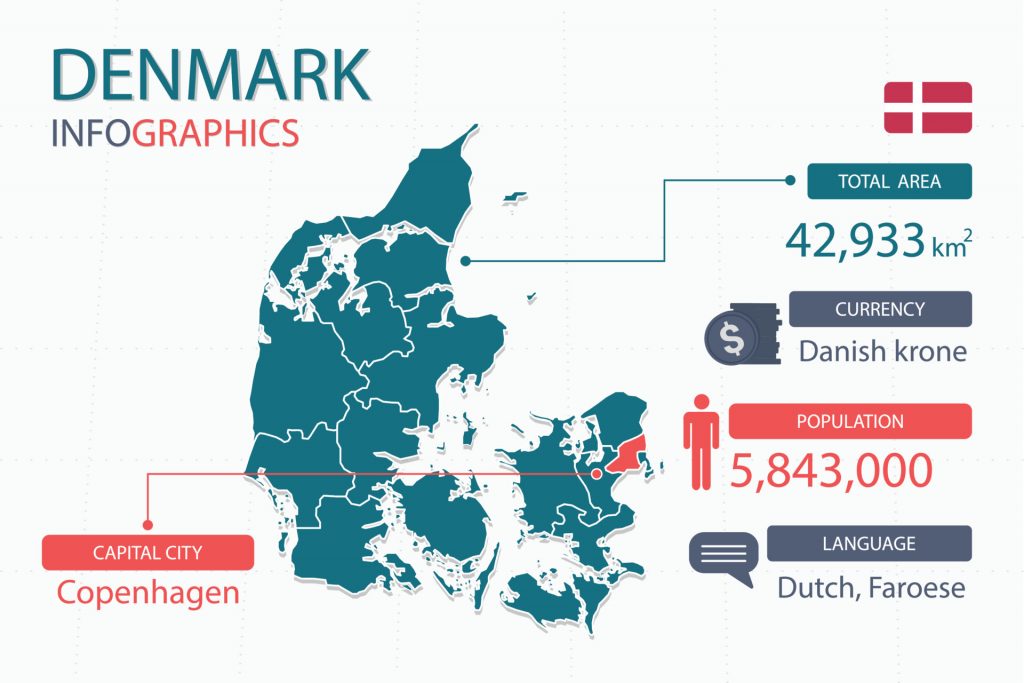The origins of the Danish Language
Danish is spoken primarily within Denmark as well as parts of Germany, Sweden, the United States, Canada, and Argentina. In fact, it is a designated minority language in Southern Schleswig, a state in Germany, and holds the same status in Greenland. About six million people speak it as a first language. It is also an official language of international organizations such as the Nordic Council and the European Union. It is mutually intelligible to certain degrees with other Scandinavian languages such as Norwegian and Swedish, and to a lesser extent with Icelandic.
Danish is classified as a North Germanic language and more specifically an East Scandinavian language; these were the languages that stem from Old Norse, which also included Icelandic, Norwegian, Faroese, and Swedish. Unique characteristics of Danish that are not familiar to native speakers of the language or related closely related ones may include its gender system for nouns (male and female), the fact that the verb is always in the second position, and the way definitive articles are expressed: In English, a speaker may say ‘the cars’, but in Danish this idea can be expressed in one word, ‘bilerne’. Another interesting feature is the way numbers are expressed. For numbers above 20, the single units are said before the numerals in the tens’ place. For example, 25 would literally be spoken was “five and twent.” similarly to German.

Danish vocabulary mainly stems from the Old Norse language. Other vocabulary influences, however, include Middle Low German, the German variety that existed during the medieval period. Later on, standard German also introduced loanwords as well as French, because of their cultural influence. After World War II, English became a source of loanwords because of its influence as an international language. Of course, Greek and Latin words are also used because of their influence in the development of philosophy, science, and technology throughout world history.
Similarly to English, Danish is written with the Latin alphabet, but with some letters and characteristics of punctuation that are uniquely Danish. For example, there are three additional letters besides the standard set, which includes æ, ø, and å to signify native Danish sounds. These letters all have upper-case versions as well. Like English, it is written from left-to-right and has much of the same punctuation such as full stops, commas, questions marks, etc. Much of the writing rules, unlike English and other European languages, have not changed much since the 16th century. This period in the history is when the majority of Danish writing conventions were established. However, the spoken language has evolved since that time, and this may have created a situation of diglossia, where there is a gap between the spoken and written registers.
Danish can be said to have originated from Old East Norse during the middle ages along with Swedish. Linguists divide the history of the language into Old Danish and Modern Danish. Old Danish is even further divided to classify times when certain grammatical changes occurred.
Old East Norse refers to the language that would eventually become Danish and Swedish. This fact also presents itself through how Old East Norse is referred to in Sweden and Denmark — in Sweden, it is called Runic Swedish while in Denmark it is called Runic Danish. That is, the variety spoken in both countries were considered more or less the same, until the 12th century, when the two split into more distinguished dialects. Runic was used to describe the two languages because the writing system at the time employed the runic alphabet.
In the 12th century, there was a clear divergence between the varieties spoken in Denmark and Sweden. Moreover, the written language that replaced the Runic alphabet was Latin, even though some remnants of Runic texts were still preserved from this time, especially in regards to popular use. Moving on to the 14th century, Danish continued to evolve in its own way in comparison to Swedish. The variety of Danish that existed during this time was used to produce literature, administrative documents, and more. However, a true literary standardization did not occur until later on. At this time, many loan words were also absorbed into the language, specifically from Germanic languages that were prevalent at this time.
Modern Danish can be identified with the publication of the Bible in Danish in the 16th century. Danish became the language of religion at that time due to the Protestant Reformation, and thus its status as a religious, and equally as important, a literary language was cemented. Both in written and oral forms, there was linguistic standardization of the language that further differentiated it from other related Scandinavian languages such as Swedish and Norwegian. While Danish continues to develop from both a cultural and linguistic standpoint into a language with its own character and context, it still remains mutually intelligible with both Swedish and Norwegian.
Standard Danish is based around the pronunciation and vocabulary that is used in areas around Copenhagen. As so many Danish speakers live in the Copenhagen metropolitan area, standard Danish remains prevalent throughout the entire country, and the language is quite homogeneous as compared to many other languages in the world, which tend to have a variety of dialects. However, the language continues to change in Denmark because of the arrival of immigrants, where the languages of these communities (most notably Arabic and Turkish) have given birth to a mixed dialect. These dialects can be heard in more urban areas where the immigrant communities can be found.
Even though Danish is the primary language of Denmark, there is no law designating it as an official language, similar to how there is no law in the United States that designates English as the official language. However, legislation has been proposed to change this situation. Regardless, it is an official language in the Faroe Islands, and up until 2009, was an official language of Greenland. A number of Danish-speaking communities exist around the world. Thus, while there does not seem to be that many speakers compared to much larger languages, its geographical reach, and influence, as well as the country’s prominence in the Nordic region, makes it an important language.
VEQTA can provide you with a perfect Danish translator for your Danish translation, English to Danish translation and Danish to english translation for the your targeted locale. Our translations to Danish are created with your target audience in mind to meet your expectations.
If you need to translate Danish – Get in touch today!
A dedicated team of Danish translators who combines Experience, Specialized Subject Matter Expertise with best Translation Practices to deliver quality second to none.
Danish Document Translation
Danish Legal Translation
Danish I.T Translation
Danish Health & Fitness Translation
Danish Medical Translation
Danish Marketing Translation
Danish Financial & Accounting Translation
Danish Tourism & Travel Translation


